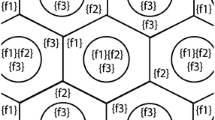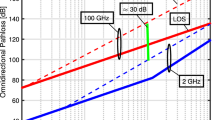Abstract
This paper addresses the comparison of characteristics between the bands of40 and 60 GHz, prospectively allocated for Mobile Broadband CommunicationSystems. The key difference between the two bands is the oxygen absorption,which is negligible at 40 GHz, but presents high values at 60 GHz, decreasingfrom 14 dB/km (at 62 GHz) down to approximately 1 dB/km (at 66 GHz). Theimpact of this excess absorption is two-fold: on one hand it reduces thereceived signal power but on the other hand it also reduces the co-channelinterference. These two quantities may not suffer the same amount ofreduction, and hence differences in the reuse pattern may result. The resultsshow that for the regular coverage geometries the difference in the reusepattern obtained in both bands is not relevant, a value of 3 being achieved.Differences however exist in the range of maximum coverage distances valuesat 43.5 GHz being up to 20% larger than at 66 GHz. For irregular urbangeometries the results obtained from specific cellular layouts, show that thereuse pattern is the same for both bands (in the range 5–7)for the the range of coverage distances where the system operationinterference limited (say, for coverage distances less than 124 m).Again, larger coverage lengths can be achieved at 40 GHz, although with ahigher associated reuse pattern.
Similar content being viewed by others
References
L. Fernandes, “Developing a System Concept and Technologies for Mobile Broadband Communications”, IEEE Personal Communications Magazine, Vol. 2, No. 1, pp. 54–59, 1995.
W.C.Y. Lee, Mobile Cellular Telecommunications Systems, McGraw-Hill: New York, New York, U.S.A., 1989.
R. Steele and V.K. Prabhu, “High-User Density Digital Mobile Radio Systems”, IEE Proceedings, Pt. F, Vol. 132, No. 5, pp. 396–404, 1985.
F. Giannetti, M. Luise and R. Reggiannini, “Mobile and Personal Communications in the 60 GHz Band: A Survey”, Wireless Personal Communications, Vol. 11, No. 10, pp. 207–243, 1999.
Y.D. Yao and A.U.H. Sheikh, “Outage Probability Analysis of for Microcell Mobile Radio Systems with Cochannel Interferers in Rician/Rayleigh Fading Environment”, IEE Electronics Letters, Vol. 26, No. 13, pp. 864–866, 1990.
L.M. Correia and P.O. Francês, “A Propagation Model for the Average Received Power in an Outdoor Environment in the Millimetrewave Band”, in Proc. of VTC'94 — 44th IEEE Vehicular Technology Conference, Stockholm, Sweden, June 1994, pp. 1785–1788.
ITU-R, “Attenuation by Atmospheric Gases”, Recommendations and Reports of the ITU-R, Report 719–2, Vol. V (Propagation in Non-ionised Media), International Telecommunications Union, Geneva, Switzerland, 1994.
ITU-R, “Attenuation by Hydrometeors, in Particular Precipitation, and Other Atmospheric Particles”, Recommendations and Reports of the ITU-R, Report 721–2, Vol. V (Propagation in Non-Ionised Media), International Telecommunications Union, Geneva, Switzerland, 1994.
R. Dinis and A. Gusmão, “Adaptative Serial OQAM-Type Receivers for Mobile Broadband Communications”, in Proc. of IEEE 45th Vehicular Technology Conference, Chicago, Illinois, U.S.A., July 1995, pp. 200–205.
J. Fernandes and C. Fernandes, “Impact of Shaped Lens Antennas on MBS”, in Proc. of PIMRC'98 — 9th IEEE International Symposium on Personal Indoor, and Mobile Radio Communications, Boston, Massachussets, U.S.A., Sep. 1998, pp. 749–753.
F.J. Velez and L.M. Correia, “Optimization Criteria for Cellular Planning of Mobile Broadband Systems in Linear and Urban Coverages”, in Proc. ACTS Mobile Communication Summit, Aalborg, Denmark, Oct. 1997, pp. 199–205.
J.M. Brázio and F.J. Velez, “Design of Cell Size and Frequency Reuse for a Millimetrewave Highway Coverage Cellular Communications System”, in Proc. of PIMRC'96 — 7th IEEE International Symposium on Personal Indoor, and Mobile Radio Communications, Taipei, Taiwan, Oct. 1996, pp. 203–207.
R. Dinis, A. Gusmão and J. Fernandes, “Performance Evaluation of Equalization/Diversity Schemes for MBS”, in Proc. of RACE Mobile Telecommunications Summit, Cascais, Portugal, Nov. 1995, pp. 230–235.
F.J. Velez and J.M. Brázio, “Microcellular Design and System Capacity Determination for Outdoors Urban Mobile Broadband Communication Systems in the Millimetrewave Bands”, in Proc. of ICT'98 —International Conference on Telecommunications, Chalkidiki, Greece, June 1998, pp. 280–284.
Map of Lisbon, Chart number 431, Scale 1:25000, Portuguese Army Surveying Institute, 1993.
J. Zoellner and C. Beall, “A Breakthrough in Spectrum Conserving Frequency Assignment Technology”, IEEE Transactions on Electromagnetic Compatibility, Vol. EMC-19, No. 3, pp. 313–319, 1977.
Author information
Authors and Affiliations
Rights and permissions
About this article
Cite this article
Velez, F.J., Correia, L.M. & Brázio, J.M. Frequency Reuse and System Capacity in Mobile Broadband Systems: Comparison between the 40 and 60 GHz Bands. Wireless Personal Communications 19, 1–24 (2001). https://doi.org/10.1023/A:1011982127267
Issue Date:
DOI: https://doi.org/10.1023/A:1011982127267




